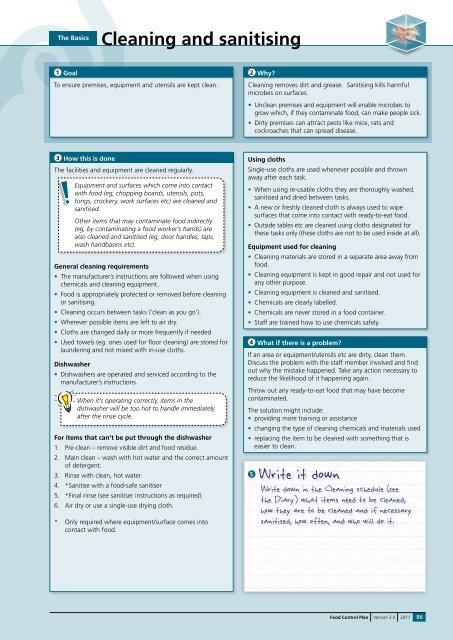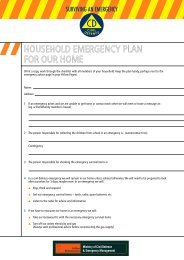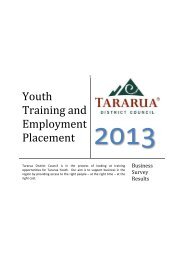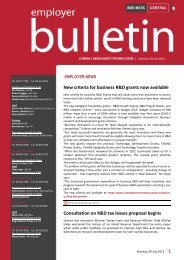Food Control Plan Checklist - Tararua District Council
Food Control Plan Checklist - Tararua District Council
Food Control Plan Checklist - Tararua District Council
- No tags were found...
You also want an ePaper? Increase the reach of your titles
YUMPU automatically turns print PDFs into web optimized ePapers that Google loves.
The BasicsCleaning and sanitising1 Goal 2 Why?To ensure premises, equipment and utensils are kept clean.Cleaning removes dirt and grease. Sanitising kills harmfulmicrobes on surfaces.• Unclean premises and equipment will enable microbes togrow which, if they contaminate food, can make people sick.• Dirty premises can attract pests like mice, rats andcockroaches that can spread disease.3 How this is doneThe facilities and equipment are cleaned regularly.Equipment and surfaces which come into contactwith food (eg, chopping boards, utensils, pots,tongs, crockery, work surfaces etc) are cleaned andsanitised.Other items that may contaminate food indirectly(eg, by contaminating a food worker’s hands) arealso cleaned and sanitised (eg, door handles, taps,wash handbasins etc).General cleaning requirements• The manufacturer’s instructions are followed when usingchemicals and cleaning equipment.• <strong>Food</strong> is appropriately protected or removed before cleaningor sanitising.• Cleaning occurs between tasks (‘clean as you go’).• Wherever possible items are left to air dry.• Cloths are changed daily or more frequently if needed• Used towels (eg. ones used for floor cleaning) are stored forlaundering and not mixed with in-use cloths.Dishwasher• Dishwashers are operated and serviced according to themanufacturer’s instructions.When it’s operating correctly, items in thedishwasher will be too hot to handle immediatelyafter the rinse cycle.For items that can’t be put through the dishwasher1. Pre-clean – remove visible dirt and food residue.2. Main clean – wash with hot water and the correct amountof detergent.3. Rinse with clean, hot water.4. *Sanitise with a food-safe sanitiser5. *Final rinse (see sanitiser instructions as required).6. Air dry or use a single-use drying cloth.* Only required where equipment/surface comes intocontact with food.Using clothsSingle-use cloths are used whenever possible and thrownaway after each task.• When using re-usable cloths they are thoroughly washed,sanitised and dried between tasks.• A new or freshly cleaned cloth is always used to wipesurfaces that come into contact with ready-to-eat food.• Outside tables etc are cleaned using cloths designated forthese tasks only (these cloths are not to be used inside at all).Equipment used for cleaning• Cleaning materials are stored in a separate area away fromfood.• Cleaning equipment is kept in good repair and not used forany other purpose.• Cleaning equipment is cleaned and sanitised.• Chemicals are clearly labelled.• Chemicals are never stored in a food container.• Staff are trained how to use chemicals safely.4 What if there is a problem?If an area or equipment/utensils etc are dirty, clean them.Discuss the problem with the staff member involved and findout why the mistake happened. Take any action necessary toreduce the likelihood of it happening again.Throw out any ready-to-eat food that may have becomecontaminated.The solution might include:• providing more training or assistance• changing the type of cleaning chemicals and materials used• replacing the item to be cleaned with something that iseasier to clean.5Write it downWrite down in the Cleaning schedule (seethe Diary) what items need to be cleaned,how they are to be cleaned and if necessarysanitised, how often, and who will do it.<strong>Food</strong> <strong>Control</strong> <strong>Plan</strong> Version 3.0 2011B6







